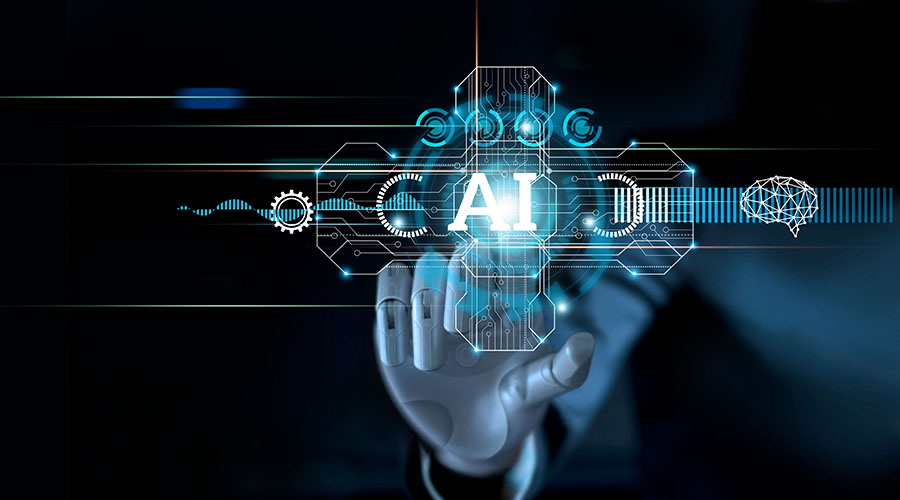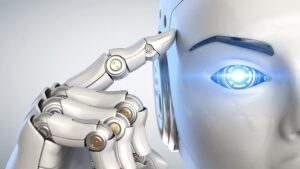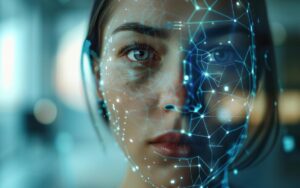Artificial Intelligence (AI) has taken the world by storm, and today, it’s an integral part of our daily lives. It’s everywhere, from virtual assistants and personalized recommendations on streaming platforms to AI tools like ChatGPT and DALL-E. But despite its ubiquity, AI still remains a bit of a mystery to many. How does AI work? What exactly is it capable of? And how can one get started in the exciting field of AI and ML?
In this post, we will dig into the fundamental concepts of AI and provide a beginner’s guide to understanding how artificial intelligence works. We will explore the various techniques and algorithms that power AI, the data-driven approaches that enable it to learn and adapt, and the different types of AI that exist today. By the end of this post, you will have a solid foundation for understanding how AI works and how you can get started in this exciting field.
What Is AI All About?
At the most superficial level, AI is about using computer systems to handle tasks humans have generally performed throughout history. These tasks include creating art and content, making decisions, translating languages, managing customer service issues, filing insurance claims, giving recommendations, and more.
Also Read: Exploring AI vs. Machine Learning
Defining Artificial Intelligence
AI, or Artificial Intelligence, refers to using computer systems to perform tasks that would typically require human intelligence. At its core, AI involves creating algorithms and models that can analyze data, identify patterns, and make decisions based on that analysis. This technology is designed to learn and adapt over time, enabling it to perform increasingly complex tasks more accurately and efficiently.
The ultimate goal of AI is to create machines that can think and reason like humans and perform tasks that are beyond the capability of humans alone. Strong and Weak AI are two categories of artificial intelligence based on their level of intelligence and ability to mimic human cognition. So, how do these types of AI work?
Strong AI
Strong AI is a hypothetical form of artificial intelligence that would possess a consciousness and general intelligence at a human-like level. It’s when machines can think, reason, and make decisions like humans. While this type of AI is still science fiction, researchers continue to explore ways to develop more sophisticated and intelligent machines. Examples of strong AI in popular culture include the sentient robots in the movie series Terminator and the android Data in Star Trek: The Next Generation.
Weak AI
Weak AI is the current form of artificial intelligence that can perform specific tasks that typically require human intelligence. These machines can only perform the tasks they were designed for and cannot think or reason beyond their programming. Examples of weak AI include virtual assistants like Siri, Alexa, and Google Assistant, which use natural language processing and machine learning algorithms to understand and respond to user queries. Other examples include self-driving cars, chatbots, and recommendation systems on e-commerce websites.
Also Read: What is Edge AI?
Types of AI
AI systems can be broadly categorized into four types based on their capabilities and complexity. The four types of AI are reactive machines, limited memory, theory of mind, and self-awareness.
Let’s dive deeper into these types of AI, their characteristics, and their examples.
1. Reactive Machines
A reactive machine is the most basic type of AI. These machines are designed to perceive and react to the world in front of them without being able to store memories or past experiences. Reactive machines can only complete limited and specialized duties. However, the benefits of a reactive machine are that it is reliable and trustworthy. The best examples of reactive machines are Deep Blue and Google’s AlphaGo.
Examples of Reactive Machines:
Deep Blue: Designed by IBM in the 1990s, Deep Blue was a chess-playing supercomputer that defeated international grandmaster Gary Kasparov in a game.
Google’s AlphaGo: AlphaGo is a machine-learning algorithm that can play the board game “Go” at a superhuman level. It uses a neural network to evaluate the current game developments, giving it an edge over Deep Blue in a more complex game.
2. Limited Memory
Limited memory AI is more complex than reactive machines. It has the ability to store previous data and predictions while gathering information and weighing potential decisions. Limited memory AI presents greater possibilities than reactive machines. It is created when a team continuously trains a model to analyze and utilize new data, or an AI environment is built so models can be automatically trained and renewed.
The steps to utilizing limited memory AI in machine learning are:
- Establish training data
- Create the machine learning model
- Ensure the model can make predictions
- Ensure the model can receive human or environmental feedback
- Store human and environmental feedback as data
- Reiterate the steps above as a cycle
3. Theory of Mind
The theory of mind is a concept based on the psychological premise of understanding that other living things have thoughts and emotions that affect the behavior of oneself. In terms of AI, this would mean that machines could comprehend how humans, animals, and other machines feel and make decisions through self-reflection and determination. They would then utilize that information to make decisions of their own.
Examples of Theory of Mind:
Currently, there are no examples of theory of mind in AI because we don’t yet have the technological and scientific capabilities necessary to reach this level of AI.
4. Self Awareness
Self-awareness in AI relies on researchers understanding the premise of consciousness and then learning how to replicate it to build it into machines. This type of AI possesses human-level consciousness and understands its own existence in the world and the presence and emotional state of others. It would be able to understand what others may need based on what they communicate to them and how they communicate it.
Examples of Self-Awareness:
There are no examples of self-aware AI because we have yet to achieve the technological and scientific capabilities necessary to reach this level of AI.
Also Read: Tech Innovation Challenges: Exploring Ethics in AI
How Does AI Work and What is Under the Hood?
AI, or artificial intelligence, is the field of computer science that focuses on creating intelligent machines that can learn and perform tasks without being explicitly programmed. The development of AI has enabled computers to perform complex tasks that were previously only possible for humans. AI uses several methods to achieve its objectives, including machine learning, neural networks, natural language processing, and robotics. So, let’s dive deeper in the effort to answer the question: how does artificial intelligence work?
Machine Learning
Machine learning is a subset of AI that enables computers to learn and improve independently by analyzing and adapting to data. There are several machine learning techniques, but the three main ones are supervised, unsupervised, and reinforcement learning.
- Supervised Learning: Supervised learning involves training a model on labeled data, which means the data set includes inputs and the desired outputs. The algorithm learns from these labeled data points and can then predict new, unseen data. Examples of supervised learning include image classification, spam detection, and speech recognition.
- Unsupervised Learning: Unsupervised learning involves finding patterns in unlabeled data, which means the data set includes only inputs with no corresponding outputs. The algorithm looks for patterns and relationships in the data and uses these patterns to make predictions on new, unseen data. Examples of unsupervised learning include clustering, anomaly detection, and dimensionality reduction.
- Reinforcement Learning: Reinforcement learning involves training a model through trial and error by rewarding or punishing specific actions. The algorithm learns through interaction with an environment and receives rewards for correct actions and punishments for incorrect ones. Reinforcement learning is commonly used in robotics, gaming, and recommendation systems.
- Other types of machine learning: In addition to supervised, unsupervised, and reinforcement learning, other machine learning techniques are commonly used. These include semi-supervised learning, where the model learns from labeled and unlabeled data, and deep learning, which uses neural networks to learn from vast amounts of data. Transfer learning is another popular technique using a pre-trained model as a starting point for a new task.
Neural Networks
Neural networks are a subset of machine learning that utilizes a network of artificial neurons to process and analyze data. They are modeled after the structure and function of the human brain, allowing them to identify patterns and relationships within data sets.
Neural networks are a powerful tool in the field of AI, particularly in the area of machine learning.
Neural networks can be trained on large datasets and learn to make predictions and decisions based on that data. This makes them useful for various applications, including image and speech recognition, natural language processing, and game playing. The ability of neural networks to learn and improve over time through feedback makes them an essential component of many AI systems.
Natural Language Processing
Natural language processing (NLP) is a crucial component of AI that enables computers to process, analyze, and understand human language. NLP involves developing algorithms and models that can interpret and derive meaning from human speech or text, which allows machines to perform various tasks such as language translation, sentiment analysis, and chatbot interactions. By enabling machines to understand human language, NLP makes it possible to create more sophisticated and intuitive AI applications that interact with humans more naturally and effectively, enhancing the overall user experience.
Robotics
Robotics is an essential component of AI and involves creating intelligent machines that can perform tasks autonomously. Robotics helps AI by providing a physical platform for machines to interact with the real world and gather data. It involves designing, building, and programming robots to perform complex, dangerous, or impossible tasks for humans.
Robotics has many applications, including manufacturing, healthcare, and space exploration.
By integrating AI and robotics, machines can learn and adapt to new situations, improve their performance, and become more autonomous, leading to more efficient and effective outcomes.
Also Read: The Double-Edged Sword of AI Deepfakes: Implications and Innovations
Application of AI in Different Industries
Artificial intelligence, commonly known as AI, is a game-changer that can revolutionize how businesses function, healthcare is delivered, education is imparted, and entertainment is experienced. Its versatility knows no bounds and has made significant strides in various industries.
This section will delve into AI’s practical applications and discover how it’s poised to transform marketing, customer service, medical imaging analysis, personalized learning, gaming, and beyond. So, how does AI work in practice?
Business
AI has the potential to revolutionize the way businesses operate. It can automate routine tasks, analyze large amounts of data, and provide insights to inform decision-making. In particular, AI significantly impacts marketing, customer service, and fraud detection. With AI-powered marketing, businesses can deliver personalized content to customers and improve the effectiveness of their campaigns. AI can also improve customer service by automating responses to common queries and resolving issues more quickly. Additionally, AI can help businesses detect and prevent fraud by analyzing patterns and identifying anomalies in financial transactions.
Examples of how AI works in business:
- Chatbots for customer service: Many businesses use AI-powered chatbots to provide customer support and address inquiries. These chatbots can handle basic customer interactions, allowing human representatives to handle more complex issues.
- Predictive analytics: Businesses can use AI-powered predictive analytics to forecast trends and identify patterns in customer behavior. This information can help businesses make more informed decisions about product development, marketing strategies, and sales forecasts.
Healthcare
AI is transforming the healthcare industry by improving diagnostic accuracy, developing new treatments, and enabling personalized care. Medical imaging analysis, for example, uses AI algorithms to analyze medical images and identify abnormalities or potential diseases. AI can also be used to develop new drugs and treatments by analyzing large amounts of data and identifying potential targets. Additionally, AI-powered diagnostic systems can help doctors make more accurate diagnoses and recommend the best patient treatment.
Examples of how AI works in healthcare:
- Medical imaging analysis: AI can analyze medical images such as X-rays, CT scans, and MRIs to detect signs of diseases such as cancer. This technology can help medical professionals diagnose conditions more accurately and quickly.
- Personalized medicine: AI can analyze a patient’s genetic data and medical history to develop customized treatment plans. This approach can lead to more effective treatments and improved patient outcomes.
Education
AI has the potential to transform education by providing personalized learning experiences and intelligent tutoring systems. Personalized learning uses AI to adapt learning materials to each student’s individual needs and preferences, improving engagement and retention. On the other hand, intelligent tutoring systems use AI to provide personalized feedback and guidance to students as they learn. This can help students learn more effectively and improve their performance.
Examples of how AI works in education:
- Medical imaging analysis: AI can analyze medical images such as X-rays, CT scans, and MRIs to detect signs of diseases such as cancer. This technology can help medical professionals diagnose conditions more accurately and quickly.
- Personalized medicine: AI can analyze a patient’s genetic data and medical history to develop customized treatment plans. This approach can lead to more effective treatments and improved patient outcomes.
Entertainment
AI is also transforming the entertainment industry by enabling new forms of gaming and content creation. AI-powered games can provide more immersive and engaging experiences by adapting to players’ behavior and preferences. AI can also generate new forms of content, such as music or art, by analyzing existing examples and creating new variations. Additionally, AI can improve the user experience of existing products, such as streaming services, by providing personalized recommendations based on user behavior.
Examples of how AI works in entertainment:
- Recommendation engines: AI-powered recommendation engines are used by streaming services such as Netflix and Spotify to suggest content based on a user’s viewing or listening history. This technology can help users discover new content they might enjoy.
- Video game AI: AI is used to control non-player characters (NPCs) and provide a more immersive gaming experience. AI-powered NPCs can react to the player’s actions, making the game more challenging and engaging.
Also Read: Performance Modeling: What is an ROC Curve?
Give Your Career a Successful Start in AI
AI and ML are rapidly growing fields where the possibilities are endless. AI has already demonstrated its potential to transform healthcare, education, business, and entertainment. New developments in machine learning, neural networks, natural language processing, and robotics will likely pave the way for more jobs and new opportunities. With such a vast scope, the demand for AI professionals is on the rise, and it is a promising career path for those looking to pursue this field.
If you’re an aspiring AI professional, taking an AI and ML course can be the first step toward building a successful career in AI. The AI ML program provides industry-specific training and masterclasses that equip learners with the knowledge and skills needed to excel in their careers.
If you are looking to take your first steps into the world of AI or enhance your existing skills, this course can be one of the best investments you’ll make in your career. Enroll today to get started!
You might also like to read:
Exploring the Artificial Intelligence Career Path
What Is a Generative Adversarial Network? Types, How They Work, Pros, and Cons
What Is Transfer Learning in Machine Learning?






